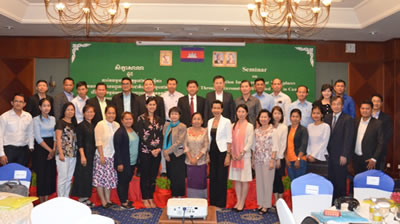|
| CHP(Center for Health
Promotion)
|
Project
IDEA  |
The Iron Deficiency Elimination Action (Project IDEA) works
to reduce micronutrient malnutrition through food fortification
in developing countries. |
|
|
Activity
up-to-date |
|
|
"Survey of Lysine Intake and Opportunities for Improving Lysine Intake in India" |
| The final reports have been submitted on the collaboration between St. Johns Research Institute, Dr. Kurpad and ILSI Japan CHP, which started in August 2016, on “Survey of Lysine Intake and Opportunities for Improving Lysine Intake in India”. The reports consisted of 2 parts and Part 1 was “Defining the Risk of Dietary Quality Protein Deficiency in India”, and Part 2 was “Agro-economic Study of Lysine Supply in India and Mitigating the Risk of Quality Protein Deficiency”. The results of Part 1 have already been published in the Journal of Nutrition (J. Nutr.-2017-Minocha-jn.116.243980) |
| |
|
"Work-place Nutrition Improvement Project by Introduction of Fortified Rice in Cambodia"
|
| The Nutrition Japan Public-Private Partnership Project (NJPPP) was initiated by the Japanese Cabinet Secretariat, Office of Healthcare Policy 2 years ago. Under this project, the “Work-place Nutrition Improvement Project by Introduction of Fortified Rice in Cambodia” project was approved last year. In order to investigate the potential feasibility of this project, 2 members of ILSI Japan CHP visited government agencies, the international NGO (RACHA), and private companies from Japan in Cambodia during September 2017 and investigated whether the introduction of fortified rice to lunch menus in work-places could improve the nutritional condition of workers. In addition, a seminar was given to the people in charge of this project in February 2018. |
|

|
|
|
|
|
|
|
|
Achievements
to date |
|
|
|
In the Philippines, ILSI CHP has worked
with FNRI on the stability and acceptability of several alternatives
for the fortification of rice with iron. The overall evaluation
indicated that extruded rice with ferrous sulfate and micronized
ferric pyrophosphate are the most stable and have the most acceptable
taste and color. An efficacy study was conducted for 6 months
in 2004 by means of an intervention program using primary school
pupils 6-8 years old in Metro Manila. The intervention program
demonstrated that both of fortification alternatives significantly
improved anemia prevalence. A market trial started in April 2008
and confirmed the effectiveness in Orion Municipality. In Cambodia,
fish sauce fortified with NaFeEDTA was introduced in Kampot in
March 2007 and Siem Reap in August. ILSI Japan CHP is working
with RACHA to promote social marketing programs, to establish
quality monitoring of the market and to establish a surveillance
system for monitoring IDA. The effectiveness of the fortification
was confirmed. Akzo Nobel is supporting the project by donating
NaFeEDTA. A literature search on complementary feeding resulted
in the report "Towards improved infant and young child nutrition
in Asia through appropriate complementary feeding" which
can be used as a basis for the research and development of complementary
feeding. In Vietnam, in collaboration with National Institute
of Nutrition (NIN), ILSI CHP has pursued iron fortification (NaFeEDTA)
of fish sauce. A series of studies verified that regular consumption
of iron-fortified fish sauce significantly reduced the prevalence
of anemia. Iron-fortified fish sauce was launched in 2006 based
on the scientific outcomes of the research and development. The
plan calls for 10 large production plants to produce fortified
fish sauce by 2009. With financial support from GAIN, the national
launch is scheduled in 5 years, which will include programs for
production/distribution, quality assurance, communication of nutrition
and health and monitoring/surveillance. ILSI Japan CHP will continue
to provide professional support to ensure a successful national
launch. In China, the Iron Fortified Soy Sauce Program has been
launched since 2004 as the national policy to prevent anemia by
ILSI Focal Point in China and CDC China. |
|
|
|
Vietnam
Partner: National Institute of Nutrition (NIN)
Fish sauce fortification with iron (NaFeEDTA)

|
|
|
Feasibility study
(1997-1998)
The National Anemia and Nutrition Risk Factor Survey (1995)
reported that anemia is highly prevalent (40-50%) among children
and women of reproductive age. The study concluded that more
than 80% of the national population consumes commercially produced
fish sauce regularly. Also the study concluded that NaFeEDTA
has high potential as an iron fortificant in fish sauce due
to favorable taste, color and smell.
Storage and stability test and sensory
evaluation (1999)
The storage and stability test concluded that the addition of
NaFeEDTA makes fish sauce slightly darker, but this color change
occurs to ordinary fish sauce by a natural degradation process.
Also the study recommended using amber glass bottles or clear
bottles under indirect or limited sunlight to prevent accelerated
degradation (1). The bioavailability
trial confirmed that daily intake of iron fortified fish sauce
positively influenced the iron status of the study participants
(2). The sensory evaluation was conducted
using 85 Vietnamese women, who compared the color, flavor, taste
and overall acceptability of iron-fortified fish sauce (5mg
Fe/10ml) and ordinary fish sauce. No significant difference
in sensory profile between two types of fish sauce was found.
Efficacy Study (April to October,
2000)
A randomized controlled trial was conducted with 152 anemic
women in the Red River Delta of Vietnam. The study participants
received either 10mg iron as NaFeEDTA / 10ml fish sauce or non-fortified
fish sauce with lunch, six days per week for 6 months. At the
conclusion of the trial, hemoglobin and serum ferritin concentrations
were found to have improved in the intervention group. The study
identified that regular consumption of fish sauce fortified
with NaFeEDTA improved iron status significantly and decreases
the prevalence of anemia (3).
Effectiveness study / market trial
(2001-2003)
A randomized double blind village-based intervention study was
conducted over 18 months. All families of two communes (an estimated
14,000 people) received iron fortified fish sauce (5mg/10ml).
Results obtained from selected group of 288 women verified that
the hemoglobin concentration increased and the prevalence of
anemia decreased following daily intake of iron fortified fish
sauce (4).
National launch (2005-2009)
Based on these findings, NIN received financial support from
GAIN (Global Alliance for Improved Nutrition) to initiate the
national launch of an iron fortified fish sauce program. The
program called for 10 large fish sauce factories to produce
iron fortified fish sauce over 5 years. The program consisited
of production/distribution, quality assurance, social marketing/consumer
education and monitoring/surveillance. ILSI Japan CHP provided
professional support to ensure a successful national launch.
By the end of the program, more than 575,000 people had access
to iron fortified fish sauce nationwide.

|
|
|
Rice fortification with iron (micronized
ferric pyrophosphate)

|
|
|
Feasibility study (2008-2009)
According to the National Anemia, Nutrition Risk Factor Survey,
2000, the prevalence of anemia in preschool aged children was
34.1% and in women of reproductive age it was 24.3%. The study
found that rice is the staple food in Vietnam, consumed in approximately
the following amount, 400g/person/day.
Storage and stability test and sensory
evaluation (2010)
To be up-dated
Efficacy Study (2010-2011)
A randomized control trial was conducted using 250 women (20-49
years old) in garment factories in Hung Yen Province, Vietnam
for 6 months starting in May 2010. 15mg Fe/ 150g rice was served
as lunch. The premix rice used in the study was produced in the
FNRI (Food and Nutrition Research Institute, the Philippines),
using an extrusion technology. The evaluation includes anemia
status and impact on vitamin A, zinc and selenium. The study indicated
that regular consumption of iron fortified rice significantly
reduced anemia prevalence and helps absorption of Vietnam A and
zinc.

|
|
The Philippines
Partner: Food and Nutrition Research Institute (FNRI)
Rice fortification with iron (ferrous
sulfate and micronized ferric pyrophosphate)

|
|
|
Feasibility study (2000-2003)
According to the National Nutrition Survey (1998), the anemia
prevalence is approximately 35% for children 7-9 years old, 36%
for women of reproductive age, and 51% for pregnant women. The
study found that rice is the stable food in the Philippines and
is consumed 3 times per day, average 386g/capita/day.
Storage and stability test and sensory
evaluation (2003-2004)
The study was conducted using the iron premix rice, enriched rice
(iron fortified rice) and cooked iron fortified rice with different
packaging materials over 10 months. The evaluation analyzed color,
texture, bulk density, infestation, iron content, microbial properties,
sensory properties. The overall evaluation indicated that extruded
rice with ferrous sulfate and micronized dispersible ferric pyrophosphate
are the most stable and have the most acceptable taste and color.
Efficacy Study (2004)
A randomized controlled trial was conducted with 180 primary school
pupils, 6-9 year olds, for 6 months in Metropolitan Manila. The
pupils were divided into 3 groups and received either rice fortified
with either ferrous sulfate, rice fortified with micronized ferric
pyrophosphate, or ordinary rice for lunch 5 days a week. The study
demonstrated that both fortification alternatives (ferrous sulfate
and micronized ferric pyrophosphate) significantly reduced anemia
prevalence (5).
Effectiveness study / market trial (April
2008-May 2009)
A market trial was conducted in Orion Municipality (population
about 52,000), Bataan province. Premix rice containing 6mg Fe/g
was produced using micronized dispersible ferric pyrophosphate
by an extrusion process in Japan for this study. The premix rice
was blended with ordinary rice in a local mill at a ratio of 1:200
to have iron-fortified rice containing 3mg Fe/100g. The iron fortified
rice was distributed through a normal market distribution channels,
its quality was checked periodically, and this was supported by
social marketing. Market surveys showed high availability and
high acceptability of the iron-fortified rice and improved awareness
of anemia and the iron fortified rice. The prevalence of anemia
significantly decreased among children (6-9 years old) (from 17.5%
to 12.8%).The study also demonstrated that political support and
social marketing activities were crucial elements in commercializing
iron fortified rice (6).

|
|
Cambodia
Partner: Reproductive and Child Health Alliance (RACHA)
National sub-committee for food fortification (NSCFF)
Fish sauce and soy sauce fortification with
iron (NaFeEDTA)

|
|
|
Feasibility study
(2004)
According to the Demographic Health Survey (2000), the anemia
prevalence is approximately 57% among children, and 62% among
women of reproductive age. The study conducted in Kampot province
showed that 62% of families used fish sauce 7 days a week, for
an average of 26ml/meal/family. The study concluded that the
fish sauce is an appropriate food vehicle for fortification
with iron in order to decrease the high prevalence of anemia
in Cambodia.
Storage and stability test and sensory
evaluation (2004)
The storage and stability test conducted in Japan showed that
the iron fortified fish sauce darkened the fish sauce slightly,
particularly fish sauce made with river fish which start as
a clear amber color. The sensory evaluation was conducted using
90 Cambodian people using iron fortified soy sauce and iron
fortified fish sauce. There was no difference in the preference
scores between iron fortified soy sauce and ordinary soy sauce.
For the iron fortified fish sauce, the preference scores of
aroma, color, and taste were significantly higher than those
of ordinary fish sauce.
Efficacy Study (Jan-Jun 2005)
The randomized controlled trial was conducted with 140 anemic
school children (6-21 years old) in Kampot province. 10ml of
fish sauce were served as lunch meal for 17 weeks. The study
indicated that regular consumption of iron fortified fish sauce
under strict control significantly improved iron status among
anemic school children (7).
Effectiveness study / market trial
(2007-2009)
A market trial using iron fortified fish sauce and soy sauce
was conducted in Kampot province, Siem Reap province and Phnom
Penh for 2 years. Three fish sauce and soy sauce factories at
each study site installed fortification facility and produced
iron fortified fish sauce and soy sauce containing 4mg Fe/10ml.
The iron fortified fish sauce and soy sauce were distributed
through normal market channels, its quality was checked in provincial
laboratories. The social marketing and health education was
provided through RACHA's network. The result demonstrated that
the consumption of fortified fish sauce and soy sauce significantly
reduced anemia prevalence and improved iron status among anemic
people.
National launch (2010〜)
In July 2010, the workshop was held to develop consensus among
stakeholders on action necessary to sustain and expand iron
fortification programs using fish sauce and soy sauce as a strategy
for reducing IDA throughout Cambodia. A proposal for a national
launch was agreed to by the Global Alliance for Improved Nutrition
(GAIN) in March 2011. Inviting industries and government officials,
the national workshop for launching project iron fortified fish
sauce and soy sauce was held in Novermber 2011. A national kick-off
meeting will be held in 2012.
|
|
India
Partner: ILSI India
Flour/ Rice fortification with iron
and lysine
|
|
|
|
Feasibility study (2012)
To be up-dated
|
 |
|
|
Publications
|
|
|
|
|
|
1
|
|
Fidler, et.
al., Photostability of Sodium Iron Ethylenediaminetetraacetic
Acid (NaFeEDTA) in Stored Fish Sauce and Soy Sauce, Journal
of Food Science, Dec 2004, Volume 69, Issue 9,
pages S380-S383.
|
|
|
|
|
2
|
|
Fidler et.
al., Iron absorption from fish sauce and soy sauce fortified
with sodium iron EDTA, Am J Clin Nutr. 2003 Aug;78(2):274-278.
|
|
|
|
| 3 |
|
Pham et. al.,
Regular consumption of NaFeEDTA-fortified fish sauce improves
iron status and reduces the prevalence of anemia in anemic
Vietnamese women, Am J Clin Nutr. Aug 2003, Vol.
78, No. 2, 284-290.
|
|
|
|
| 4 |
|
Pham et. al.,
The Use of NaFeEDTA-Fortified Fish Sauce Is an Effective
Tool for Controlling Iron Deficiency in Women of Childbearing
Age in Rural Vietnam, J Nutr. 2005 Nov;135(11):2596-601.
|
|
|
|
| 5 |
|
Angeles-Agdeppa
et. al., Efficacy of iron-fortified rice in
reducing anemia among schoolchildren in the Philippines,
Int J Vitam Nutr Res. 2008 Mar;78(2):74-86.
|
|
|
|
| 6 |
|
Angeles-Agdeppa
et. al., Pilot-scale commercialization of iron-fortified
rice: effects on anemia status, Food Nutr Bull. 2011
Mar;32(1):3-12.
|
|
|
|
| 7 |
|
Longfils et.
al., A comparative intervention trial on fish sauce
fortified with NaFe-EDTA and FeSO4+citrate in iron deficiency
anemic school children in Kampot, Cambodia, Asia Pac
J Clin Nutr 2008;17 (2):250-257. |
|
|
|
|
|
|
Donors and
supporting organizations for Project IDEA
(Alphabetic
order) |
|
The programs of ILSI CHP
Japan have been supported by donations from the public and private
sector. ILSI CHP Japan very much appreciates the generous contributions. |
|
|
|
Ajinomoto Co., Inc.
Akzo Nobel Company
Global Alliance for Improved Nutrition (GAIN)
The Iijima Memorial Foundation For
The Promotion of Food Science and Technology
Ministry of Agriculture, Forestry and Fisheries (MAFF)
Taiyo Kagaku Co.,Ltd.
|
|
|
Scientific
advisors |
|
|
|
Prof. Masamine Jimba, Department of Community
and
Global Health, The University of Tokyo
Dr. Yukiko Nakanishi, College of Nutrition, Koshien University
Prof. Sean Rynch, Department of Internal Medicine,
Eastern Virginia Medical School
|
|
|
|
|
|
|
|
|
 |
|
|
|
|
|
(March 2018)
|
|
|
|
|
|
Copyright © 2004-2024 International
Life Sciences Institute Japan , All Rights Reserved
|

